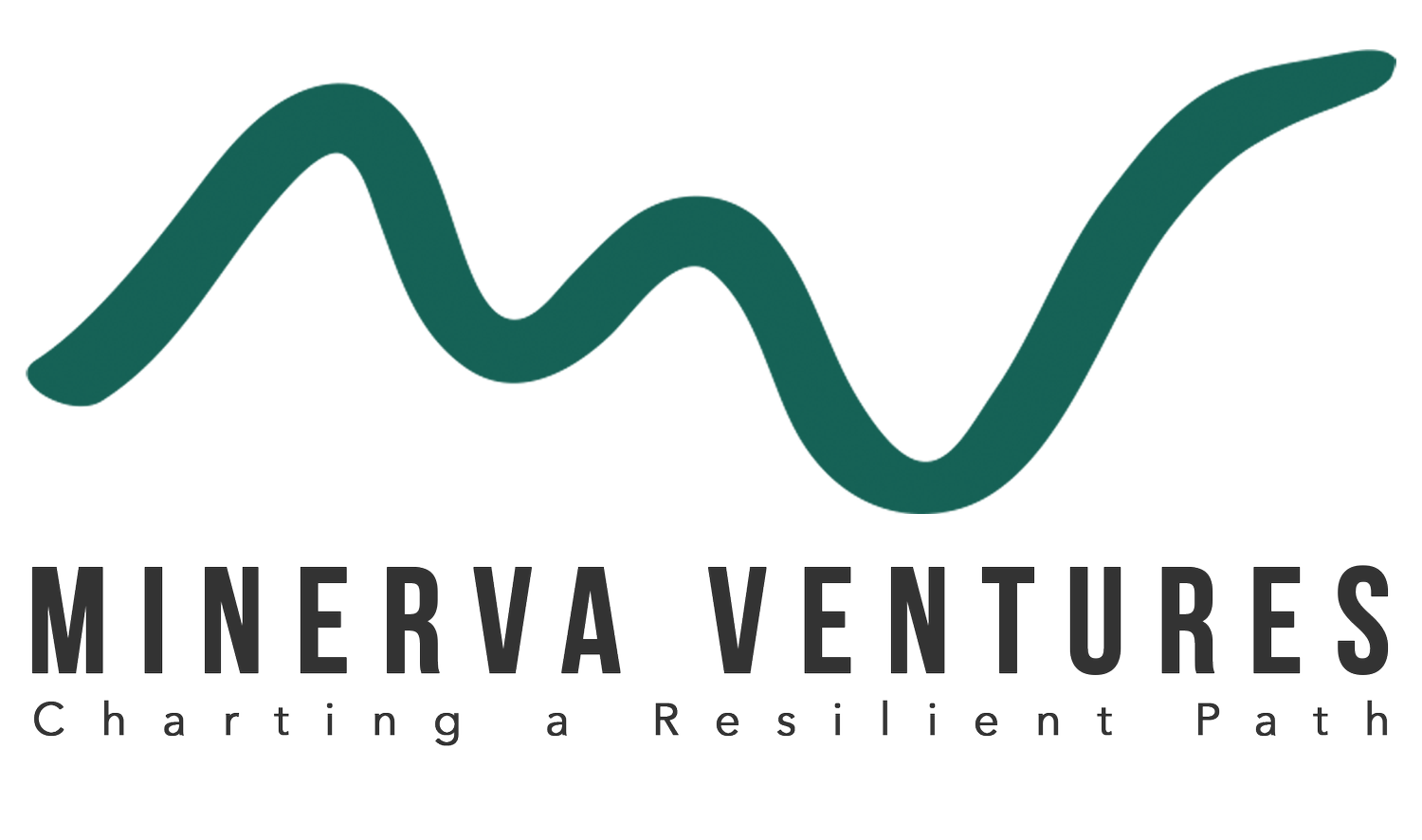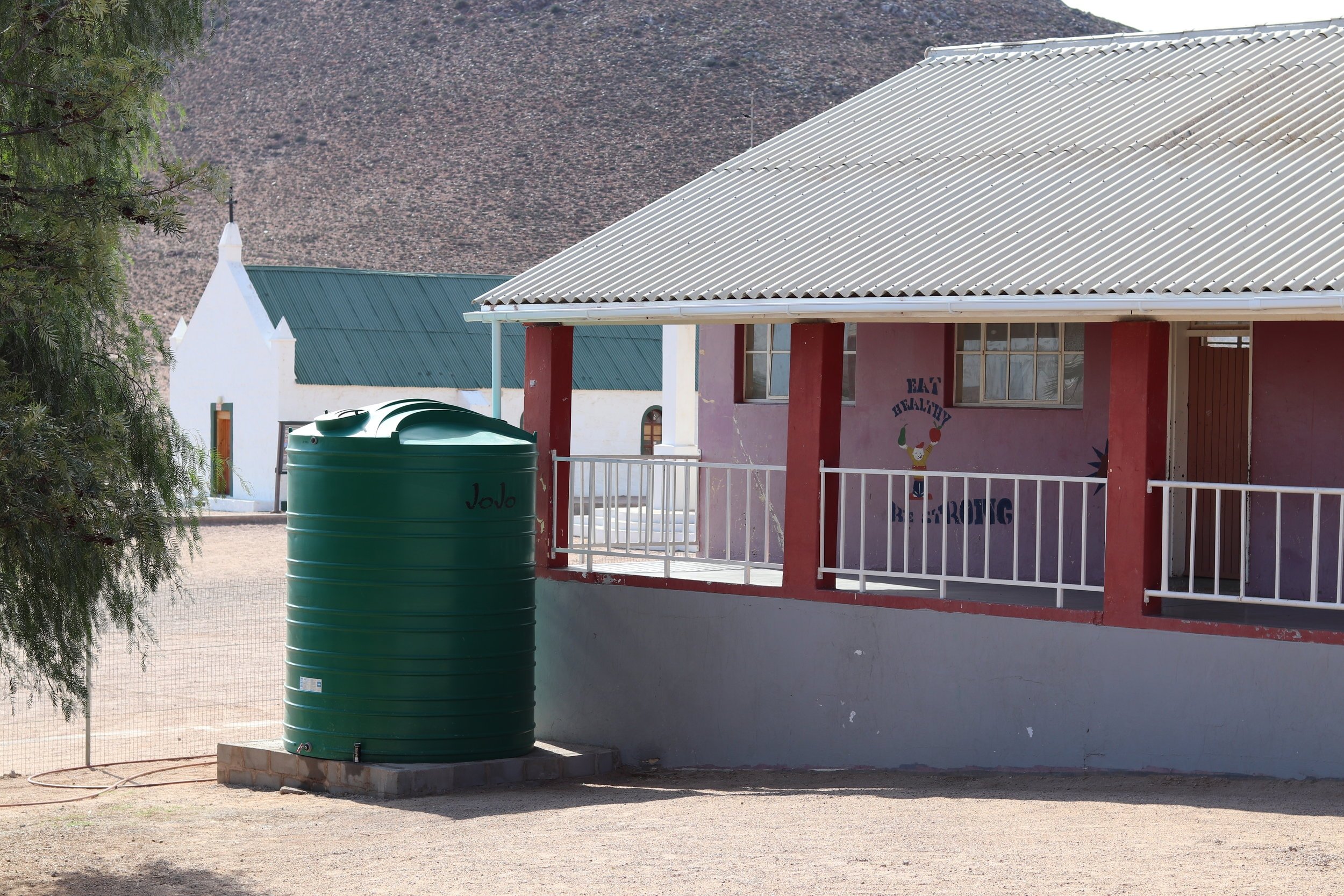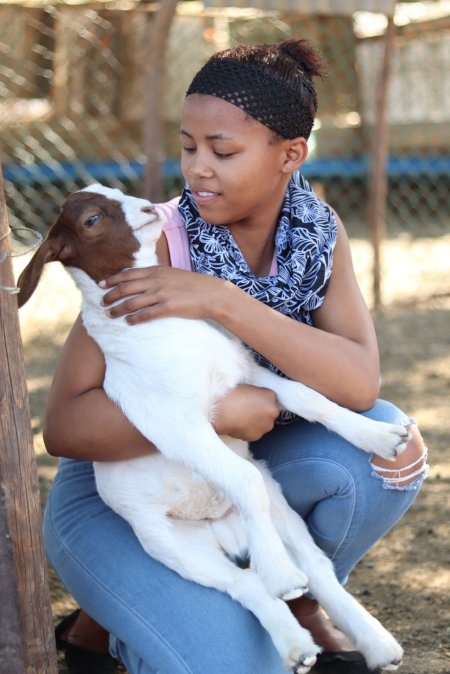Climate Adaptation in South Africa
Recently, Minerva’s Karl Van Orsdol completed a climate vulnerability assessment project in the town of Kuboes, South Africa. Kuboes (Population 1,000) is an isolated indigenous community of Nama Peoples located in the Northern Cape province which, like Cape Town some 600 km to the south, has been reeling under the effects of a major drought. When founded in 1849, the landscape around Kuboes was a perfect spot for the herders and grazers traditional to Nama culture. But over the past 20 years, a changing climate has reduced much of the surrounding land to an extremely arid, desert-like environment.
Climate resiliency tank and guttering installed at school in Kuboes.
The town is adjacent to the Richtersveld National Park and the Richtersveld World Heritage Site, effectively limiting the town’s use of nearby resources. The climate change vulnerability project focused on:
1) Installing climate-resilient infrastructure (construction of a rainwater capture system at the School)
2) Assessing the climate vulnerabilities facing the indigenous community of Nama peoples living in Kuboes and exploring how each of these the Kuboes Community is adapting to climate change through cultural, social, economic and resource utilization practices.
Kuboes woman
Indigenous communities around the world are at risk of experiencing direct consequences of climate change, given their dependence upon, and close relationship with, the environment and its resources. Climate change has a direct impact on those resources including the availability of food and water. In addition, climate change exacerbates the challenges faced by vulnerable indigenous communities, including economic marginalization, loss of land and resources, human rights violations, discrimination and unemployment. The Intergovernmental Panel on Climate Change (IPCC, 2001) defined vulnerability as the degree to which a system is susceptible to, or unable to cope with adverse effects of climate change, including climate variability and extremes.
Herding is important in Nama culture
Because they are often the first to experience the impacts of climate change on living standards, indigenous communities are among the first to attempt to mitigate climate risks through land use, cultural practices, habitation characteristics and resource management techniques. The adaptation approach of indigenous communities has not been systematically studied and the lessons learned have not been effectively understood by a wider audience. The broader understanding of the adaptation techniques adopted by indigenous communities can be extremely useful for other rural and underserved communities, as well as for scientists, land-use planners and governments at the regional, national and global levels.
Kuboes Woman with child
The primary points of research included assessing:
How does the community view their relationship with the natural world?
How do members of the Community's views differ among the different role-players in the community, e.g. women, youth, alders, etc.?
To what extent do they understand the process of climate change and its impact on their community?
What capacity exists within each community to deal with these changes and adapt or mitigate potential risks?
What actions, either explicit or implicit, or changes in cultural, social or ecological practices are the communities undertaking with regard to change in the local climate?
Which of these actions enable the community to effectively manage its climate risks?
What barriers (incl. non-climate barriers) do the communities face in becoming more climate resilient?
What additional resources, support or policy initiatives are needed to build climate-resilient livelihoods?
How can indigenous communities to protect their socio-ecological knowledge while facilitating information exchanges with other indigenous communities and climate scientists around the world?
Karl and the team
Four young people in the community formed a team with five South African Students from the University of the Western Cape who are studying climate issues. These student teams canvassed the community to assess the townspeople’s view of how the climate is changing in terms of distances travelled to fetch water, the location and accessibility of grazing lands, and the intensity of heat waves that hit the region during the summer. The team of students was able to canvass a total of 110 householders during the 3 weeks of the study, or more than 50% of the households in the town.
Based on the survey analysis, we assessed climate adaptation practices adopted by different segments of the community including women, the elderly and the young. Our approach focused on the process of adapting to climate change, starting from the premise that the ability of a community to adapt (adaptive capacity) is primarily a social issue and dependent on the capacity of individuals, organizations, institutions, and businesses to continually learn and drive change in response to changing climatic conditions, as well as to changing environmental, social, economic conditions (i.e., underlying non-climate stressors). This work looks to integrate climate exposure into the adaptive capacity of the community (see figure below).
Figure 1 Assessing the Vulnerability of Communities to climate change – Integrating exposure, sensitivity and adaptive capacity of a community to a changing climate.
Our assessment showed that climate change impacts represent a combination of stresses to the community’s traditional use of natural resources – especially around water sources and grazing lands. The changing climate has led to a loss of access to these resources, which has significantly impacted the economic and cultural prosperity of the community. Two-thirds of the population believed the annual and ongoing drought is critical in reducing the availability of water to the community due to the drying up of traditional water holes. This was not a surprising finding since the drought throughout Southern Africa was limiting the availability of water to many communities in the province, including Cape Town which declared a water emergency. But of equal concern to the community was that a changing climate has led to severe winds that residents cited as a new weather phenomenon. For a community based on livestock ownership, the strong winds have reduced the availability of forage for their animals. The easterly winds, coming into the Kalahari Desert, further dried out plants and covered grazing lands in dust and sand, making the plants inaccessible or undesirable to livestock. Calf mortality resulting from a reduction in grazing quality reached upwards of 75% in some herds. Other herders report single-year losses of animals reaching 50% of their total herds. Clearly, these losses are unsustainable.
But these losses are more than economic. They are leading to an erosion of cultural practices and local knowledge. The Nama the largest group of Khoikhoi people (also known as the Hottentots), have mostly disappeared as a group. The Nama practice a policy of communal land ownership. Storytelling, music and poetry are very important in Nama culture and many stories have been passed down orally through the generations. This oral history is often based on livestock herding as a way of life. The Nama have a culture that is rich in the musical and literary abilities of its people. Traditional music, folk tales, proverbs, and praise poetry have been handed down for generations and form the base for much of their culture.
The town of Kuboes
A changing climate, combined with the loss of traditional lands has put traditional herders into a box. Unable to roam across the landscape, these herders are seeing their available forage and water resources deteriorate to the point that many are abandoning their traditional lifestyles. Poverty is dramatically increasing. Over 50% of the Kuboes community reported having no income at all as they abandon grazing.
The community of Kuboes, and many other indigenous communities, don’t normally fit into our discussions around the impact of climate change. We mostly debate the impacts of climate change on the world’s cities. But we need to be cognizant of the huge cultural loss to the world that climate change is having on our indigenous populations.
About the Author: Karl Van Orsdol is a climate scientist with Minerva Ventures. This research was funded by The Rockies Institute of Alberta Canada, the South African National Parks and the South African Agricultural Research Council, and anonymous donors. Karl thanks them for their support.








